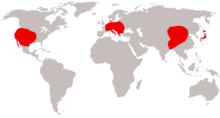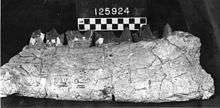Amynodontidae
Amynodontidae ("threatening tooth")[2] is a family of extinct perissodactyls related to true rhinoceroses. They are commonly portrayed as semiaquatic hippo-like rhinos[3][4] but this description only fits members of the Metamynodontini; other groups of amynodonts like the cadurcodontines had more typical ungulate proportions and convergently evolved a tapir-like proboscis. Their fossils have been found in North America, and Eurasia ranging in age from the Middle Eocene to the Early Oligocene, with a single genus (Cadurcotherium) surviving into the Late Oligocene in South Asia (Pakistan).[5] The genus Metamynodon may have survived into the early Miocene.
| Amynodontidae | |
|---|---|
| Scientific classification | |
| Kingdom: | Animalia |
| Phylum: | Chordata |
| Class: | Mammalia |
| Order: | Perissodactyla |
| Superfamily: | Rhinocerotoidea |
| Family: | †Amynodontidae |
| Genera[1] | |
|
See text | |
 | |
| Range of Amynodontidae based on fossil record | |

Zaisanamynodon protheroi
Taxonomy
†Amynodontidae
- Subfamily Amynodontinae
- Tribe Cadurcodontini
- Tribe Metamynodontini
- Genus Gigantamynodon[6]
- Genus Metamynodon
- Genus Paramynodon[6]
- Genus Zaisanamynodon[6]
- Tribe incertae sedis
- Genus Amynodon[6]
- Subfamily incertae sedis
gollark: Carcinization complete.
gollark: I agree.
gollark: Perhaps I am *actually* to implement this sort of combat-agents thing.
gollark: In <@160279332454006795>'s thing, the population of each type of agent was also adjusted up/down depending on their score.
gollark: .
References
- McKenna, M. C; S. K. Bell (1997). Classification of Mammals Above the Species Level. Columbia University Press. ISBN 0-231-11012-X.
- American Museum of Natural History, "Perissodactyls Glossary"
- Savage, RJG; Long, MR (1986). Mammal Evolution: an illustrated guide. New York: Facts on File. pp. 194. ISBN 0-8160-1194-X.
- Palmer, D., ed. (1999). The Marshall Illustrated Encyclopedia of Dinosaurs and Prehistoric Animals. London: Marshall Editions. p. 264. ISBN 1-84028-152-9.
- Wall, William P. (1989). "The phylogenetic history and adaptive radiation of the Amynodontidae". In Prothero, Donald R; Schoch, Robert M. (eds.). The Evolution of perissodactyls. Oxford University Press. ISBN 9780195060393.
- Averianov, A.; Danilov, I.; et al. (2017). "A new amynodontid from the Eocene of South China and phylogeny of Amynodontidae (Perissodactyla: Rhinocerotoidea)". Journal of Systematic Palaeontology. 15 (11): 927–945. doi:10.1080/14772019.2016.1256914.
- von Koenigswald, W.; Holbrook, L.T.; et al. (March 2011). "Diversity and Evolution of Hunter-Schreger Band Configuration in Tooth Enamel of Perissodactyl Mammals". Acta Palaeontologica Polonica. 56 (1): 11–32. doi:10.4202/app.2010.0021.
- Huang, X.; Wang, J. (January 2001). "New materials of tapiroid and rhinocerotoid remains (Mammalia, Perissodactyla) from the Middle Eocene of Yuanqu Basin, Central China". Vertebrata Pal Asiatica. 39 (3): 197–203. Retrieved 14 August 2020.
- Antoine, P.; Ducrocq, S.; et al. (2003). "Early rhinocerotids (Mammalia: Perissodactyla) from South Asia and a review of the Holarctic Paleogene rhinocerotid record". Canadian Journal of Earth Sciences. 40 (3): 365–374. doi:10.1139/e02-101.
- Wall, W.P.; Manning, E. (July 1986). "Rostriamynodon grangeri n. gen., n. sp. of amynodontid (Perissodactyla, Rhinocerotoidea) with comments on the phylogenetic history of Eocene Amynodontidae". Paleontology. 60 (4): 911–919. Retrieved 14 August 2020.
This article is issued from Wikipedia. The text is licensed under Creative Commons - Attribution - Sharealike. Additional terms may apply for the media files.
